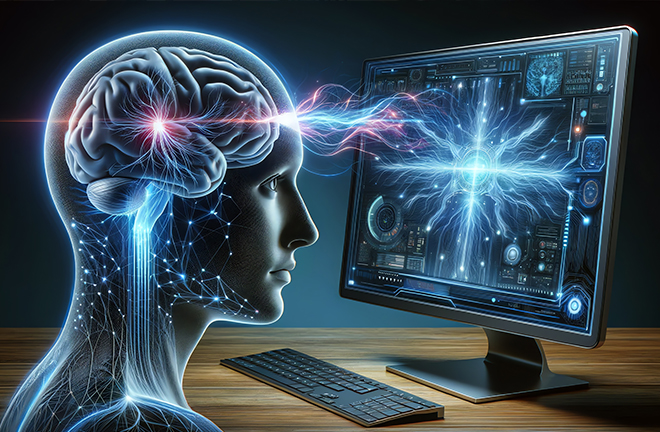Addressing the human risks of BCI

A brain-computer interface (BCI) enables a person to control an external device using brain signal. Photo: TUCHONG
The brain-computer interface (BCI) is an emerging communication and cybernetics technology that directly engages with the human body. It not only enables humans to reach the goal of “acting through thinking,” but is also revolutionizing traditional human-machine relationships and giving rise to the so-called “integrated entity” in this process. Despite the potential for human enhancement, BCI could pose various risks for human beings. For instance, technological devices may lead to adverse health effects, basic human values such as freedom and dignity could be jeopardized, and “integrated entities” could be faced with dilemmas of identity.
The key to mitigating these risks lies in harnessing synergy from multiple concepts, pairs of contradictions, and subjects. Specifically, it involves regulating the discordant factors and unstable structures within BCI systems from a humanistic perspective, through the processes of defining, reconciling, and preserving.
Defining
The rapid development of biotechnology and information technology, as well as the sophisticated integration of the two, have given rise to myriad uncertainties. The emergence of BCI exacerbates the situation, necessitating the reconstruction and reinterpretation of many human concepts. Terms such as “moral redline” and “code of conduct” now figure frequently in regulatory recommendations for BCI both in China and overseas, and specific measures including setting up BCI ethics committees have also been proposed. However, without clear definition of relevant concepts, these measures often become unreliable and inefficient. Therefore, clear definitions serve as the primary basis for addressing the human risks of BCI.
First, BCI terms such as “embodiment” and “disembodiment” should be clearly defined. This lies at the core of addressing concerns related to the attribution of liability and the free will of human-machine hybrid entities. BCI-based “integrated entities” further blur the boundaries between body and tool, underscoring the significance of clearly defining the conditions under which BCI exhibits a higher level of embodiment.
For example, if skin, bones, and natural body contours are used as boundaries, implanted chips are more “embodied” than exoskeleton devices. If normal physiological function levels are used as boundaries, BCI applications aimed at restoring and maintaining normal physiological activities manifest stronger intersubjective “embodiment” than functional enhancements with powerful performance.
Second, “restoration” and “enhancement” need to be defined, as this is crucial for optimizing resource allocation and equalizing technology. According to the type and orientation of technological intervention, BCI can be broadly categorized as therapeutic enhancement, as in the case of persons with disabilities gaining above-average speed by means of BCI-controlled exoskeleton devices, and non-therapeutic enhancement, as observed in persons without disabilities implanting chips to enhance motor performance and mental capacity.
Reconciling
Under the influence of competing schools of thought, the development trajectory and orientation of BCI technology, along with the corresponding risk management strategies, are being pulled in divergent directions. Reconciliation serves to find synergy in debates in order to guide the development of BCI technology towards a more “humanistic” orientation.
First, it is necessary to reconcile two major schools of thought: bioconservatism and transhumanism. Bioconservatism opposes the development of “potentially threatening” technologies, and views human enhancement as a process of “decentralization of humanity” and “dehumanization.” Conversely, transhumanism views human enhancement as a rational approach to unlocking the full potential of humans and embracing human nature, while asserting that bioconservatism impedes human advancement.
There are many other forms of theoretical confrontation in this regard. A more viable “third way” can only become possible through the reconciliation of conflicting humanistic concepts and the integration of feasible governance decisions.
Second, the “technological development” and “humanistic development” of BCI need to be reconciled. Due to the lack of interaction between natural sciences and humanities, there is a mismatch between BCI technology and corresponding humanistic regulations, as the regulations lag behind technological advancements and tend to be overly general. To better align technology with humanistic principles, a “trading zone” should be established to promote dialogue between different fields and improve the disciplinary diversity of members of technology research and development teams.
Preserving
Fundamentally, mitigating the human risks of BCI requires the preservation of humanistic foundations. First, it is important to establish regulatory systems targeting BCI risks on the basis of understanding its ultimate orientation - human-centeredness. In the context of advanced technology, “responsible innovation” is increasingly attracting attention from the field of humanistic philosophy of technology. Humanistic regulations can be understood as codes of conduct that serve and protect humans.
As BCI is a recent technological achievement involving a wide range of disciplines, and its humanistic value has yet to be explicitly defined, traditional one-dimensional regulations have gradually become inadequate. To address BCI risks, is necessary to build humanistic regulatory systems characterized by comprehensiveness, flexibility, and diversity.
Second, human intellectual and cultural memory should be preserved. The cornerstone of human identity shifts from the natural human body to commensurable heterogeneous communication, sending a warning signal to humans. Fortunately, preserving intellectual and cultural memory constitutes a safeguard for maintaining human identity. This requires minimizing the reverse intervention of BCI devices on the human brain in the absence of medical necessity so as to ensure the reliability of this carrier of intelligence and culture.
With the continuous development and extensive application of BCI, humans may experience profound “technicalization.” Humanity can better “become what it is” amid the new wave of bio-information technology by building comprehensive, flexible, and scalable regulatory systems, and “disciplining” technology within these systems.
Zhou Yanhong is a professor at Hunan Women’s University.
Edited by WANG YOURAN
